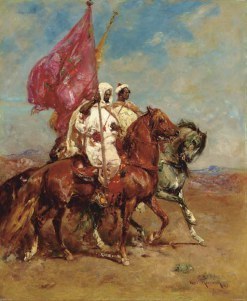The Curious Case of al-Ghazal
In the 9th Century a Moorish ambassador named al-Ghazal set sail for foreign lands to study a people called the Majus. His account tells of his voyage across the ocean to a splendid island described as having lush, flowering plants and abundant streams leading to the ocean. For years historians struggled to gather consensus on who these Majus may have been, but more recently it has become accepted that they were indeed the Vikings. Unfortunately, the consensus ends there. Some scholars believe the embassy of al-Ghazal to have taken place in Denmark, whereas others propose he had visited the court of Turgeis, a powerful warlord who ruled over much of Ireland. His account is compelling and offers a tremendous volume of information about the Majus many scholars believe no chronicler of the time could have fabricated.
The source for al-Ghazal’s embassy to Ireland is a document produced by Abu-l-Kattab-Umar-ibn-al-Hasan-ibn-Dihya, who was born in Valencia in Andalucia, about 1159 A.D. The facts and anecdotes in the story were derived from Tammam-ibn-Alqama, vizier under three consecutive amirs in Andalucia during the ninth century who died in 896. Tammam-ibn-Alqama had allegedly learned the details directly from al-Ghazal and his companions. The only manuscript of ibn-Dihya’s work was acquired by the British Museum in 1866. It is titled Al-mutrib min ashar ahli’l Maghrib, which translates to An amusing book from poetical works of the Maghreb.
The entire account is quite possibly true, and quite possibly accurate, but the subject remains debated. Nevertheless, it appears the Moors took an interest to the Vikings, no doubt a result of their early interactions with Viking explorers and tradesmen. If true, this account demonstrates yet another interaction between the Vikings and the Muslim world previously unknown to us, and is telling of the openness of Norse culture to visitors. In the account, al-Ghazal spends a great deal of time with the wife of the king of the settlement who he takes a strong liking to. The document is compelling evidence that a Muslim visited Ireland in the 9th Century and, according to his account, got very cozy with the king’s wife during his stay.
Source:
Allen, W.E.D. The Poet and the Spae-Wife. Titus Wilson and Son, Ltd. London, 1960.
Sponsored Ad






